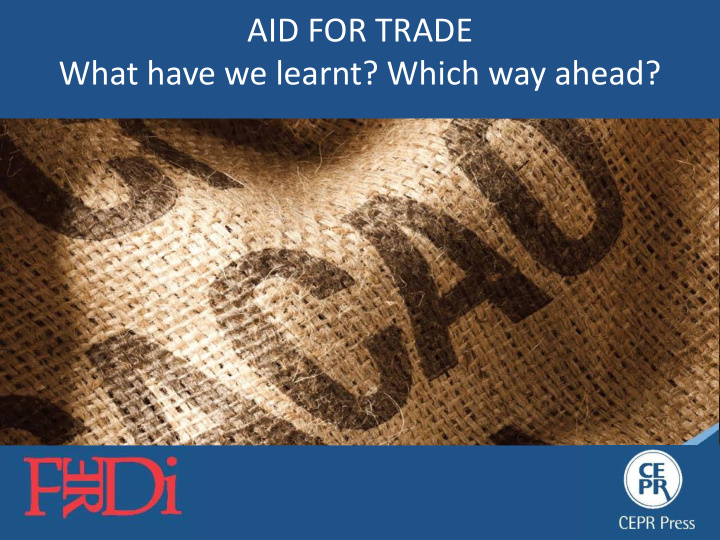



AID FOR TRADE What have we learnt? Which way ahead? 1
AID FOR TRADE What have we learnt? Which way ahead? I - Aid for Trade: Looking Ahead Olivier Cadot and Jaime de Melo II - Evaluation in Aid for Trade: From Case Study Counting to Measuring Olivier Cadot and Jaime de Melo III - Aid for Trade: What can we Learn from the Case Studies? Richard Newfarmer IV - Diagnostic Trade Integration Studies and their Updates under the Enhanced Integrated Framework – A Retrospective Paul Brenton and Ian Gillson 2
What Have we Learnt? Trade Costs have fallen less rapidly for low income countries Evolution of simulated trade costs from a gravity equation: Low income 3
What Have we Learnt? Some apparent success in mobilizing funding… 60.0% 55.0% DAC countries Decline of the share of AFT in ODA has 50.0% Multilateral been arrested, 45.0% 40.0% 35.0% 30.0% 50 25.0% 45 20.0% DAC countries Multilateral Other 1995 1997 1999 2001 2003 2005 2007 2009 Constant price billions USD 40 35 30 25 20 15 10 5 0 1995 1996 1997 1998 1999 2000 2001 2002 2003 2004 2005 2006 2007 2008 2009 2010 4
What Have we Learnt? … and in mainstreaming trade in national development strategies (… sometimes) Applying OECD word- count approach to Uganda’s budget speeches 5
What Have we Learnt? … but no faster export growth for large recipients of AFT flows o Split countries by the median in terms of 2000-2005 AFT receipts (per dollar of export) o Check if high-receivers ’ exports grew more over subsequent 5-year period (2005-10) 120.0% 100.0% 80.0% 60.0% 40.0% 20.0% 0.0% Low High Low High Low High Low High Low High Weakest Strongest Q1 Q2 Q3 Q4 Q5 exporters exporters Quintiles of the export/capita distribution 6
What have we Learnt? Macro and Micro face different trade-offs Identification of causal chain T RADE - OFF 1 Relevance of outcomes Internal validity (ability to identify a causal relation) Impact Evaluation T RADE - OFF 2 Cross-country econometrics External validity (ability to derive generalizable results) 7 7
Which way ahead? Randomista or not, evaluate RCT is not the alpha and omega of impact evaluation o What matters is baseline data collection + control group o Wealth of quasi-experimental methods available, even ex post «RCT controversy» should not be an excuse to not evaluate o Every intervention left un-evaluated is a missed learning opportunity o Evaluation raises incentive issues; incentive-compatible setups can be designed (e.g. making IE the «default» in all cases; decoupling IE results from project manager’s performance evaluation , …) Toward an «evaluation-friendly» AFT o Cut costs; e.g. use existing stats as much as possible; put pressure on governments to share statistics, in particular firm-level data o Encourage a culture of project design for evaluation (all projects designed like Progresa?) 8
Which way ahead? Streamline the initiative Exploit the opportunity offered by the Trade Facilitation Agreement o Help make trade portals useful repositories of NTMs o Provide technical assistance to Trade Facilitation Committees (Art. 13) to develop trade- related regulatory-oversight capabilities (not just counting documents to export) Better use Diagnostic Trade Integration Studies o DTIS updates already a crude form of progress monitoring; clear learning curve from first generation o Still lack of ownership (government side) and visibility (donor side) o Need for leaner, more focused action matrices (already largely the case) o Mainstream regional integration in trade policy; region-level DTISs 9
Which way ahead? In sum… AFT’s broad achievements … o Mainstreaming of trade in national development strategies o Creating a crude form of donor coordination around «competitiveness strategies» o Mobilizing funding … are at risk unless a «culture of evaluation» builds up o Donor budget pressures require credible identification of outcome improvements + causation; the instruments are there to use o Successful globalizers have all experimented with policy, but no learning from experimentation without evaluation … and the initiative gets a second wind from the TFA o A tool for the TFA’s application, focused on NTMs o A vehicle to foster deep regional integration 10
Recommend
More recommend